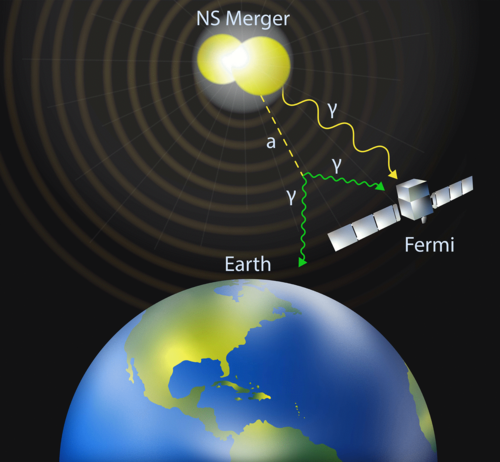The collision of two neutron stars approximately 130 million light-years from Earth and the unique physics created by this merger may have shed new light on dark matter.
New research led by University of Washington physicist Bhupal Dev suggests that neutron star mergers detected on Earth as the GW170817 gravitational wave signal could help place constraints on hypothetical particles called “axions,” a leading candidate for dark matter.
The axions have never been directly detected, but they appear in many models that push physics beyond what is called the Standard Model of particle physics; This is the best way we currently describe subatomic particles and how they interact with each other.
Relating to: What happens when neutron stars collide? Astronomers may finally know
Dark matter is a big challenge for scientists because it does not interact with light; This means that it is virtually invisible to our eyes. Dark matter also exhibits a distinct lack of interaction with other forces, such as the electromagnetic force. In general, because of these strange properties, dark matter cannot consist of electrons, protons, and neutrons, which are the components of normal matter that make up stars, planets, our bodies, and everything around us on a daily basis.
This mystery is further complicated by the fact that the everyday matter that we are aware of and that is included in the Standard Model accounts for only 15% of the total matter in the universe.
“We have good reason to suspect that new physics beyond the standard model may be lurking just around the corner,” Dev said in a statement. “Extreme astrophysical environments such as neutron star mergers provide a new window of opportunity in our search for dark sector particles such as axions that may hold the key to understanding the missing 85% of all matter in the universe.”
Are Axions hiding neutron star debris?
Neutron stars are born when massive stars exhaust the fuel supplies needed for internal nuclear fusion and can no longer support themselves against the inward push of their own gravity. As this cosmic balancing act, which has existed for millions of years, comes to an end, the outer layers of a star are blown away by a massive supernova explosion.
This leaves behind a collapsed stellar core in which the solar mass has been compressed into a width of about 12 miles (20 kilometers). It is a neutron star and is so named because it is filled with neutron-rich matter. Neutron stars are so dense that if a teaspoon of them were taken and brought to Earth, it would weigh approximately 10 million tons. That’s about 30 times as heavy as the Empire State Building.
These neutron stars do not always exist alone; sometimes they orbit a neutron star companion. As these neutron stars orbit around each other in a pattern called a neutron star binary, they create ripples in space-time called gravitational waves. As these spacetime waves propagate outward, they divert angular momentum away from the binary star, causing the stellar remnants that form it to move closer together. This continues until the neutron stars’ gravity kicks in, causing them to crash into each other and merge.
Unsurprisingly, given the extreme nature of neutron stars, a collision between two such stellar remnants triggers types of turbulent physics not seen anywhere else in the universe. In fact, scientists think that neutron star mergers are environments so violent that they can create elements heavier than iron, such as gold and silver, that even the boiling hearts of massive stars cannot create.
This is possible because neutron star collisions eject matter rich in free neutrons; The particles are generally found locked in atomic nuclei alongside just protons.
Therefore, these neutrons can be absorbed by the atomic nuclei in the region; This phenomenon is called the “rapid capture process” or “r-process”. This results in the formation of unstable, large atomic nuclei that eventually decay to form lighter elements such as gold. This decay also produces light that astronomers see as kilonovae from our vantage point on Earth.
The merger also creates a short-lived, dense remnant of two neutron stars that quickly collapses to form a black hole.
“The remnant heats up much more than the individual stars for about a second before settling into a larger neutron star or black hole, depending on the initial masses,” Dev explained. Dev thinks this means the relic is the ideal production point for exotic particles like axes.

These particles can escape from the neutron star merger region and decay into other particles, including photons, which are particles of light. Dev and his colleagues think that the decay of these runaway particles gives rise to a unique electromagnetic signal that can be captured by gamma-ray telescopes such as NASA’s Fermi space telescope.
RELATED STORIES:
— ‘Impossible’ neutron stars could explain strange flares
— How neutron star collisions filled Earth with gold and other precious metals
— Most powerful gamma-ray burst ever seen could help reveal how black holes are born
The team thinks this means Fermi and future gamma-ray detectors can focus on neutron star collisions to collect data that could improve scientists’ understanding of axions and similar particles.
This could eventually lead to the discovery of the particles that make up dark matter, solving one of the most pressing questions in cosmology: What is the universe’s “missing matter” made of?
The team’s research was published March 5 in the journal Physical Review Letters.